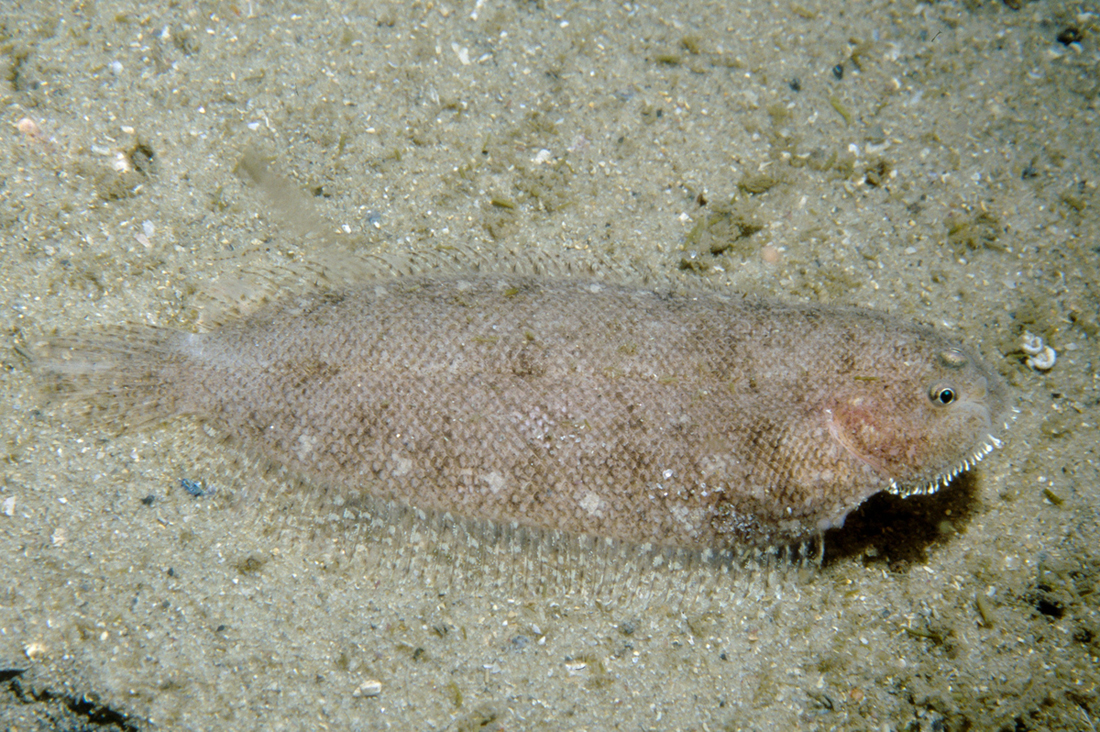- Classification
- ACTINOPTERYGII
- PLEURONECTIFORMES
- SOLEIDAE
- Aseraggodes
- lenisquamis
Peppered Sole, Aseraggodes lenisquamis Randall 2005

A Peppered Sole, Aseraggodes lenisquamis, in Chowder Bay, Sydney Harbour, New South Wales, October 2002. Source: Erik Schlogl / iNaturalist.org. License: CC by Attribution-NonCommercial
Summary:
An pale brown to orange-brown sole with diffuse blackish blotches on the upper side (the three along lateral line and one above the first blotch the largest), numerous small, irregular, dark-edged whitish spots on the head and body, and greyish-brown fin rays with small dark-edged whitish spots and white ray tips.
Cite this page as:
Bray, D.J. 2020, Aseraggodes lenisquamis in Fishes of Australia, accessed 19 Apr 2024, https://fishesofaustralia.net.au/home/species/1005
Peppered Sole, Aseraggodes lenisquamis Randall 2005
More Info
|
Distribution |
Port Stephens to Bermagui, New South Wales. Inhabits sandy areas in bays and harbours. |
|
Features |
Dorsal fin 62–70; Anal fin 46–52; both dorsal and anal-fin rays branched; Lateral-line scales 62–68, including 8–9 anterior to a vertical at upper end of gill opening; Vertebrae 36–38; Dorsal pterygiophores anterior to fourth neural spine 8–9. Body depth 2.4–2.65 in SL; head short, head length 4.75–5.05 in SL; eye diameter 4.6–5.7 in HL; upper eye overlapping about anterior one-third to one-half of lower eye; interorbital space variable in width, the vertical distance separating eyes 7.3–13.7 in HL; lappet–like cirri on ventral edge of head, but not on front of snout; numerous cirri on opercular edge of gill opening on both sides; dense cirri over much of ventral part of head; exposed surface of scales overlaid with soft tissue; only tips of cirri visible at scale margins, capped with soft tissue; lateral-line scales with fleshy cirri, often one above and one below pore (cirri better developed on ocular than blind side); scattered other scales with a slender fleshy cirrus, often one from each corner of scale; membranous ridges of both sides of dorsal and anal rays with a conspicuous fringe of cirri, some of which are bifid; lateral line aligned with upper eye. Longest dorsal ray 1.65–1.8 in HL; caudal peduncle absent; caudal fin rounded, its length 4.6–5.05 in SL; pelvic fins short, 1.8–2.2 in HL, the tip of longest ray reaching base of second anal ray. |
|
Colour |
Ocular side light brown, with scattered small dark brown blotches; rays of fins with small dark brown spots. |
|
Etymology |
The specific name lenisquamis is from the Latin lenis (= soft, smooth) and squama (= scale), in reference to the distinctive scale structure of this species. The cteni of the scales are nearly covered by soft epidermal tissue, with only the tips exposed at the scale margin. |
|
Species Citation |
Aseraggodes lenisquamis Randall 2005, Mem. Mus. Vic. 62(2): 201, fig.9. Type locality: Camp Cove, 33°50'S, 151°17'E, Sydney Harbor. New South Wales, Australia, depth 4 m. |
|
Author |
Bray, D.J. 2020 |
|
Resources |
Peppered Sole, Aseraggodes lenisquamis Randall 2005
References
Kuiter, R.H. 1993. Coastal Fishes of South-eastern Australia. Bathurst : Crawford House Press 437 pp. (p. 391, upper figure, as Aseraggodes sp.)
Randall, J.E., Bogorodsky, S.V. & Mal, A.O. 2013. Four new soles (Pleuronectiformes: Soleidae) of the genus Aseraggodes from the western Indian Ocean. Journal of the Ocean Science Foundation8: 1-17.
Randall, J.E. 2005. A review of soles of the genus Aseraggodes from the South Pacific, with descriptions of seven new species and a diagnosis of Synclidopus. Memoirs of Museum Victoria 62(2): 191-212. PDF Open access





